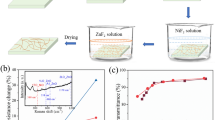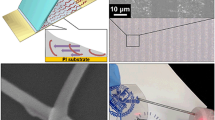Abstract
In this study, a flexible conductive filament was fabricated by mixing thermoplastic polyurethane (TPU), carbon nanotubes (CNTs), and Cu powder. A polymer extruder was used to disperse conductive materials in the TPU matrix. Because the dispersion of CNTs in polymers is difficult, the dispersion process was repeated several times for the homogeneity of the fabricated conductive filament. Cu powder with high electrical conductivity was additionally added to improve the electrical characteristics of the conductive polymer. As TPU generally has excellent ductility and durability, the fabricated filament can secure flexibility. The resistance was measured and compared according to the mixing ratio of CNT/Cu powder. Based on the obtained results, the resistance of the conductive filament decreased as the CNT and Cu powder contents were increased. The addition of metal powders, such as CNTs and Cu powder, however, reduced the ductility of TPU. Finally, the developed conductive filament was used to fabricate a simple closed photodiode circuit.










Similar content being viewed by others
References
Lee, S., et al. (2015). Ag nanowire reinforced highly stretchable conductive fibers for wearable electronics. Advanced Functional Materials, 25(21), 3114–3121.
White, M. S., et al. (2013). Ultrathin, highly flexible and stretchable PLEDs. Nature Photonics, 7(10), 811–816.
Matsuhisa, N., et al. (2015). Printable elastic conductors with a high conductivity for electronic textile applications. Nature Communications, 6(May), 1–11.
Xu, F., & Zhu, Y. (2012). Highly conductive and stretchable silver nanowire conductors. Advanced Materials, 24(37), 5117–5122.
Park, M., Park, J., & Jeong, U. (2014). Design of conductive composite elastomers for stretchable electronics. Nano Today, 9(2), 244–260.
Hu, Y., et al. (2016). Low cost and highly conductive elastic composites for flexible and printable electronics. Journal of Materials Chemistry C, 4(24), 5839–5848.
Kwok, S. W., et al. (2017). Electrically conductive filament for 3D-printed circuits and sensors. Applied Materials Today, 9, 167–175.
Kim, N. P. (2020). 3D-printed conductive carbon-infused thermoplastic polyurethane. Polymers (Basel)., 12(6), 205.
Leigh, S. J., Bradley, R. J., Purssell, C. P., Billson, D. R., & Hutchins, D. A. (2012). A simple, low-cost conductive composite material for 3D printing of electronic sensors. PLoS ONE, 7(11), 1–6.
Sui, G., Liu, D., Liu, Y., Ji, W., Zhang, Q., & Fu, Q. (2019). The dispersion of CNT in TPU matrix with different preparation methods: Solution mixing vs melt mixing. Polymer (Guildf)., 182, 121838.
Shehzad, K., et al. (2013). Effects of carbon nanotubes aspect ratio on the qualitative and quantitative aspects of frequency response of electrical conductivity and dielectric permittivity in the carbon nanotube/polymer composites. Carbon New York, 54, 105–112.
Gnanasekaran, K., et al. (2017). 3D printing of CNT- and graphene-based conductive polymer nanocomposites by fused deposition modeling. Applied Materials Today, 9, 21–28.
Zhang, J., Yang, B., Fu, F., You, F., Dong, X., & Dai, M. (2017). Resistivity and its anisotropy characterization of 3D-printed acrylonitrile butadiene styrene copolymer (ABS)/carbon black (CB) composites. Applied Science, 7(1), 1150.
Rymansaib, Z., et al. (2016). All-polystyrene 3D-printed electrochemical device with embedded carbon nanofiber-graphite-polystyrene composite conductor. Electroanalysis, 28(7), 1517–1523.
Palenzuela, C. L. M., Novotný, F., Krupička, P., Sofer, Z., & Pumera, M. (2018). 3D-printed graphene/polylactic acid electrodes promise high sensitivity in electroanalysis. Analytical Chemistry, 90(9), 5753–5757.
Experimental, M. P. C. (2022). Conductivity Behaviour under Pressure of Copper and Modelling. Springer.
Podsiadły, B., Skalski, A., Wałpuski, B., & Słoma, M. (2019). Heterophase materials for fused filament fabrication of structural electronics. Journal of Materials Science: Materials in Electronics, 30(2), 1236–1245.
Bertolini, M. C., Ramoa, S. D. A. S., Merlini, C., Barra, G. M. O., Soares, B. G., & Pegoretti, A. (2020). Hybrid composites based on thermoplastic polyurethane with a mixture of carbon nanotubes and carbon black modified with polypyrrole for electromagnetic shielding. Frontiers in Materials, 7(June), 1–9.
Ramôa, S. D., Barra, G. M., Oliveira, R. V., De Oliveira, M. G., Cossa, M., & Soares, B. G. (2013). Electrical, rheological and electromagnetic interference shielding properties of thermoplastic polyurethane/carbon nanotube composites. Polymer International, 62(10), 1477–1484.
Kim, K., Park, J., Suh, J. H., Kim, M., Jeong, Y., & Park, I. (2017). 3D printing of multiaxial force sensors using carbon nanotube (CNT)/thermoplastic polyurethane (TPU) filaments. Sensors and Actuators A Physical, 263, 493–500.
Acknowledgements
This work was supported by the National Research Foundation of Korea (NRF) Grants funded by the Korea government (MSIT) (No. 2021R1A4A1033141 and No. 2021R1F1A106-4238).
Author information
Authors and Affiliations
Contributions
All authors contributed to this paper. Experiments were performed by Hansol Kim, Seungcheol Shin, Hojin You. Data analysis and result considerations were performed by Hansol Kim, Sang-Woo Han, Inhwan Lee and Jungho Cho. The first draft of the manuscript was written by Hansol Kim and all authors commented on previous versions of the manuscript. All authors read and approved the final manuscript.
Corresponding author
Additional information
Publisher's Note
Springer Nature remains neutral with regard to jurisdictional claims in published maps and institutional affiliations.
Rights and permissions
Springer Nature or its licensor holds exclusive rights to this article under a publishing agreement with the author(s) or other rightsholder(s); author self-archiving of the accepted manuscript version of this article is solely governed by the terms of such publishing agreement and applicable law.
About this article
Cite this article
Kim, H., Yoo, H., Shin, S. et al. Development of a TPU/CNT/Cu Composite Conductive Filament with a High CNT Concentration. Int. J. Precis. Eng. Manuf. 24, 265–271 (2023). https://doi.org/10.1007/s12541-022-00712-4
Received:
Revised:
Accepted:
Published:
Issue Date:
DOI: https://doi.org/10.1007/s12541-022-00712-4




